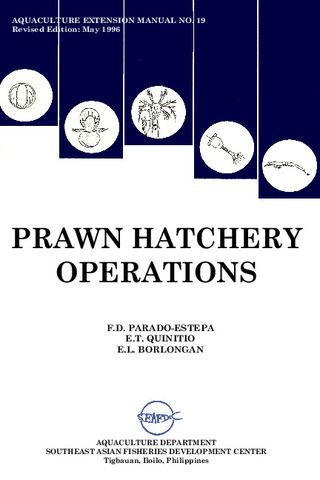Experiment on larval rearing of Penaeus monodon fed with cultured diatom Chaetoceros calcitran and fermented vegetable trash
- Global styles
- MLA
- Vancouver
- Elsevier - Harvard
- APA
- Help

วันที่
1978ผู้เขียน
Page views
1,510ASFA keyword
AGROVOC keyword
Taxonomic term
เมตาดาต้า
แสดงระเบียนรายการเต็ม
Share
นามธรรม
A brief account is given of experiments undertaken rearing Penaeus monodon larvae fed on diatom (Chaetoceros calcitran) and fermented vegetable trash, which included fruits and their peels, vegetables and rice. The possible use of high protein content trash materials as a feed substitute is examined briefly.
การอ้างอิง
Motoh, H. (1978). Experiment on larval rearing of Penaeus monodon fed with cultured diatom Chaetoceros calcitran and fermented vegetable trash. SEAFDEC Aquaculture Department Quarterly Research Report , 2(3), 33-34. http://hdl.handle.net/10862/2329
Type
Articleคอลเลกชัน
Related items
Showing items related by title, author, creator and subject.
-
An overview of the nutrition, feed and feeding techniques of prawn penaeid/shrimps
Piedad-Pascual, Felicitas (Philippine Council for Aquatic and Marine Research and Development, 1989)This paper echoes what transpired during the first International Conference of Penaeid Prawns/Shrimps held in Iloilo City in December 4-7, 1984, particularly on the Nutrition nd Feed Development. Around 25 papers were ... -
Series: Aquaculture extension manual; No. 19
Prawn hatchery operations
Parado-Estepa, Fe D.; Quinitio, Emilia T. ; Borlongan, Emeterio L. (Aquaculture Department, Southeast Asian Fisheries Development Center, 1996-05)
The manual, an updated version of the 1984 SEAFDEC/AQD manual, presents the underlying principles and step-by-step instructions of prawn larval and post-larval rearing. The techniques described are not only applicable to ...
; Borlongan, Emeterio L. (Aquaculture Department, Southeast Asian Fisheries Development Center, 1996-05)
The manual, an updated version of the 1984 SEAFDEC/AQD manual, presents the underlying principles and step-by-step instructions of prawn larval and post-larval rearing. The techniques described are not only applicable to ... -
The lowdown on world shrimp culture - II
Yap, Wilfredo G. (INFOFISH, 2001)This paper introduces some new members of the international shrimp culture club and goes on to discuss some recent technological innovations in the industry, particularly the polyculture of tilapia (mainly Oreochromis ...






